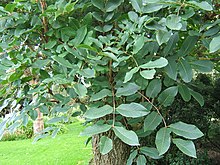Sabiaceae
| Sabiaceae | |
|---|---|
 |
|
| Meliosma veitchiorum | |
| Scientific classification | |
| Kingdom: | Plantae |
| (unranked): | Angiosperms |
| (unranked): | Eudicots |
| Order: | Proteales |
| Family: |
Sabiaceae Blume |
| Genera | |
| Synonyms | |
|
|
Sabiaceae is a family of flowering plants that were placed in the order Proteales according to the APG IV system. It comprises three genera with 66 known species, native to tropical to warm temperate regions of southern Asia and the Americas. The family has also been called Meliosmaceae Endl., 1841, nom. rej.
The anthesis is extremely short. The anthers open within the bud, but enclosed in the staminodes. On maturing the bud opens explosively at the smallest touch releasing the pollen into the air.
Plants from this genus live in humid areas along rivers, in tropical forests or in warm temperatures.
Cyanolipids absent. Pentacyclic triterpenoids, flavonols, proanthocyanidins and tannins present. The plants are not cyanogenetic.
Some species of Meliosma have a limited use in gardening and horticulture.
The fossil genus Insitiocarpus has been found in deposits from the Cenomanian period, while the other extant genera Sabia and Meliosma have been found in European deposits from the Turonian and the Maastrichtian, respectively. The appearance of the first sabiaceae has been dated to 122-118 million years ago.
Sabia macrofossils have been recovered from the late Zanclean stage of Pliocene sites in Pocapaglia, Italy.
The Sabiaceae are a group of flowering plants that are included in the Eudicots clade, where they form part of the basal level. In this regard they are similar to the Proteaceae, with which they share, for example, a nectariferous hypogynous disc, although they differ in the number of floral parts and the radial pentameric symmetry is completely original. Based on molecular and morphological data, the APW (Angiosperm Phylogeny Website) considers that they form part of the order Sabiales, which is the only representative of this intermediate clade between the Ranunculales and the Proteales (cf. AP-website).
...
Wikipedia
